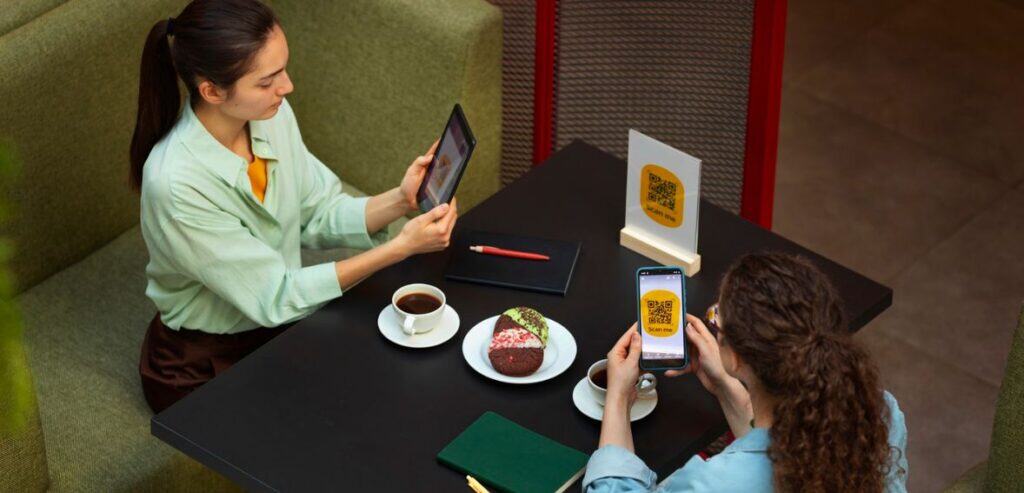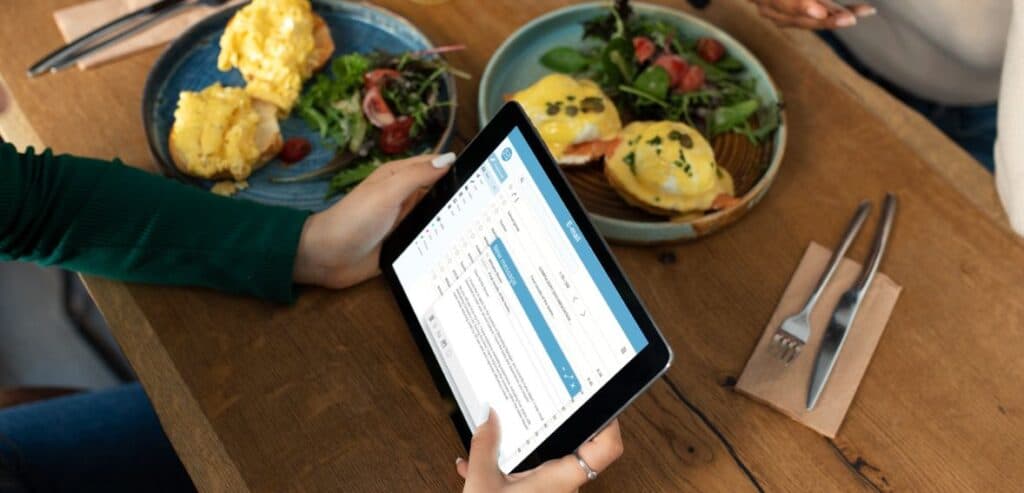
By foodbizcloud August 11, 2025
It has always taken more than just delicious food to run a successful restaurant. The guest experience is shaped by the employees—servers, hosts, bartenders, chefs, and support staff—in a field with a reputation for high employee turnover. While a poorly managed team can ruin even the best menu, a motivated and well-trained team can convert a one-time customer into a devoted regular.
However, it has never been simple to maintain your employees’ skills and engagement in a high-pressure, fast-paced workplace, particularly given the difficulties facing the labor market today. Here’s where the game is transforming to digital tools. Technology is providing restaurant managers and owners with more intelligent and efficient ways to prepare their staff and retain them, from scheduling and continuous communication to onboarding and training.
In addition, despite some people may view digital solutions as impersonal or cold, when implemented properly, they can contribute to the creation of a cozier, more connected workplace.
Rethinking Training for the Modern Restaurant

Traditional restaurant training frequently involved hours of in-person instruction, memorizing scripts from a binder, or shadowing another employee. Although experiential learning remains important, it is no longer the side choice. Purely manual training has the drawback of being inconsistent, particularly in a hectic setting where managers are balancing several tasks.
Depending on who trains them, new hires might overlook important steps or receive contradicting information, which could result in inconsistent service quality. While allowing for individual mentoring, digital tools aid in standardizing training. Every employee is guaranteed to learn the same fundamentals thanks to platforms that provide interactive tests, video-based lessons, and detailed process manuals.
This implies that regardless of who is working, a line cook learning food safety regulations or a new server learning the POS system receives precise, consistent training. Because employees can review materials before shifts or during downtime, mobile access is especially beneficial for strengthening skills without interfering with workflow.
Onboarding That Feels Personal—Even When Digital
The first few weeks of employment present one of the most significant chances to reduce turnover. According to studies, workers are much more likely to stick around if they feel capable, supported, and welcomed right away.
Delivering important information in an interactive and easily assimilated manner, such as workplace policies, menu details, and safety protocols, is made simpler by digital onboarding platforms. Managers can distribute brief, interesting modules that blend images, sound, and real-world scenarios in place of bulky packets of printed materials.
Managers can quickly identify areas where a new hire may need additional assistance thanks to these tools, which frequently track progress automatically. However, adding personal touches—such as an owner-hosted video or a team chat where new hires can ask questions—ensures that the procedure doesn’t feel robotic.
Communication as the Glue That Holds Teams Together
Without ongoing communication, even the best training may not be effective. In addition to chat apps and scheduling platforms, many managers now use cloud-based food business tools that centralize messaging, labor management, and real-time updates—ensuring teams stay connected and informed across shifts.
Everyone can stay informed in real time with the use of digital communication tools, such as internal announcement boards, scheduling platforms with messaging capabilities, or specialized workplace chat apps. Without depending on last-minute phone calls or word-of-mouth, employees can check their schedules, switch shifts, and get updates about upcoming events or menu changes.
The benefit goes beyond operational effectiveness; it also promotes inclusivity. Every team member is more likely to feel like a vital component of the operation when they are all involved. Particularly for seasonal or part-time employees who might otherwise feel alienated, this can boost morale and loyalty.
Using Data to Strengthen Performance and Engagement

Tracking performance data is one of the more sophisticated advantages of digital tools. Targeted coaching can be guided by specific metrics, such as order accuracy, service speed, or upselling success. Integrated restaurant POS software systems often include these analytics features—and when leveraged effectively, they empower managers to identify strengths, address knowledge gaps, and recognize top performers in real time.
For example, a server may be allowed to publicly acknowledge their efforts and inspire others if they routinely receive high customer satisfaction ratings. Managers can also provide skill-specific refresher training if some team members have trouble with the same procedure.
Utilizing data as a tool for empowerment rather than punishment is crucial. Employees are more likely to embrace tracking if they see it as a way to help them succeed rather than a way to catch mistakes.
Retention Through Continuous Learning
Pay and perks aren’t the only factors in retention; growth is also important. Many restaurant employees quit because they don’t see a way to advance, not because they don’t enjoy their jobs. By providing continuous skill development beyond the fundamentals, digital learning platforms can alter that.
For example, a line cook could acquire new culinary skills that equip them for a lead role, or a bartender could receive advanced mixology training. Cross-training employees for various roles can also increase their sense of career investment and provide scheduling flexibility. Employees are more likely to remain engaged and dedicated if they believe they are developing.
Building a Culture Around Technology
It’s important to keep in mind that technology is a tool, not a culture unto itself. A workplace where all human interaction is replaced by digital tools will find it difficult to preserve warmth and unity. Digital solutions are used by the most successful restaurants to supplement human management, not to replace it.
This entails combining in-person check-ins with real-time digital communication, combining online training with practical mentoring, and utilizing performance metrics to encourage productive dialogues rather than micromanage. Although digital tools can increase process efficiency, employee loyalty is ultimately maintained by respect, trust, and personal recognition.
Balancing Digital and Human Touch

It’s simple to become involved in the efficiency that digital tools provide, but restaurants need to keep in mind that these solutions are only as good as the human culture that supports them. Portland’s independent pizzeria discovered this the hard way.
They observed a decline in staff participation following the implementation of a scheduling and communication platform. The technology wasn’t the problem; rather, managers had ceased in-person check-ins because they believed the app would suffice.
Engagement and morale increased when they resumed the brief daily pre-shift huddles. The lesson learned? Digital tools are most effective when used in conjunction with personal leadership, not in place of it. Employees need to know that their managers are still concerned enough to communicate with them directly, even though technology may handle logistics.
Getting Staff Buy-In for New Tools
Without staff adoption, even the most advanced software will not work. Employee participation in the decision-making process from the start is essential for successful implementation. Before launching a new ordering and training app, a Texas casual dining chain asked its kitchen and server staff what features would be most useful to them.
By incorporating the team’s suggestions, they were able to focus on features that enhanced workflow rather than superfluous ones that would have made use more difficult. By assigning less tech-savvy team members to “digital champions” who could assist during the transition, they also took the time to train everyone on the new system.
After using the platform for a month, managers observed that there were fewer scheduling conflicts, shift changes went more smoothly, and onboarding for new hires went more smoothly.
Why Digital Training and Retention Strategies Work Now More Than Ever
The restaurant industry has encountered previously unheard-of staffing issues since the pandemic. Employees now have more choices and higher standards, and companies that don’t adjust run the risk of losing both talent and clients. Because digital tools provide flexibility, transparency, and accessibility—three qualities that today’s workforce highly values—they are a perfect fit with these realities.
Employees are more likely to feel supported when they can communicate easily, view their schedules in real time, train at their own pace, and access resources on their phones. Additionally, managers can create stronger, more resilient workplaces when can monitor performance trends, onboard new hires promptly, and maintain communication with the team.
Measuring the Impact of Digital Tools

Determining whether digital solutions are having an impact is just as crucial as putting them into practice. After implementing an e-learning platform for staff training, a small Miami bistro began monitoring important metrics. Over six months, they assessed guest satisfaction ratings, average training completion times, and employee turnover rates.
The findings were striking: customer feedback consistently mentioned friendlier, more knowledgeable staff, training time decreased by almost a week, and turnover decreased by 18%. These figures not only supported the original investment but also assisted management in improving the training materials.
By treating digital tools as part of an ongoing improvement cycle, restaurants can ensure they’re not just adopting technology for the sake of it, but actively using it to enhance both staff performance and the guest experience.
Conclusion
Human connections—between employees and customers, between managers and their teams—will always be at the heart of the restaurant industry. The satisfaction of a well-prepared meal or the warmth of a warm greeting cannot be replaced by digital tools, but they can free up time and energy so that those moments occur more frequently.
Restaurants can increase productivity and create an environment where employees want to stay by simplifying training, enhancing communication, encouraging lifelong learning, and fairly and openly monitoring performance. A more stable, competent, and driven workforce benefits both customers and employees in an industry where turnover is frequently viewed as unavoidable. This is made possible by the combination of intelligent digital tools and real human leadership.